
A digital camera is a camera that captures photographs in digital memory. Most cameras produced today are digital, largely replacing those that capture images on photographic film. Digital cameras are now widely incorporated into mobile devices like smartphones with the same or more capabilities and features of dedicated cameras. High-end, high-definition dedicated cameras are still commonly used by professionals and those who desire to take higher-quality photographs.
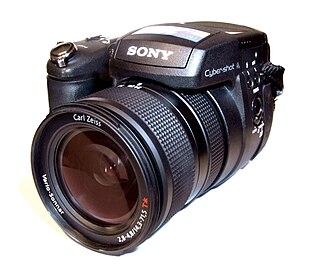
The Sony Cyber-shot DSC-R1 is a bridge digital camera announced by Sony in 2005. It featured a 10.3 megapixel APS-C CMOS sensor, a size typically used in DSLRs and rarely used in bridge cameras. This was the first time such a large sensor was incorporated into a bridge camera. Besides the APS-C sensor, the DSC-R1 also featured a 14.3–71.5 mm Carl Zeiss Vario-Sonnar T* lens, providing for an angle of view equivalent to 24–120 mm on a full frame camera.

Bridge cameras are cameras that fill the niche between relatively simple point-and-shoot cameras and interchangeable-lens cameras such as mirrorless cameras and single-lens reflex cameras (SLRs). They are often comparable in size and weight to the smallest digital SLRs (DSLR), but lack interchangeable lenses, and almost all digital bridge cameras lack an optical viewfinder system. The phrase "bridge camera" has been in use at least since the 1980s, and continues to be used with digital cameras. The term was originally used to refer to film cameras which "bridged the gap" between point-and-shoot cameras and SLRs.
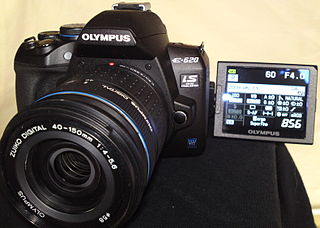
An articulating screen is a built-in small electronic visual display which is not fixed, but rather can be repositioned using a hinge or pivot. The articulating screen is known under different other names such as flip-out screen, flip screen, adjustable screen, articulated screen, or hinged screen. According to the way it moves, there are four main types:
- The display moves around one axis, so that it only tilts. It is called tilting screen or tiltable screen.
- The display tilts horizontally both up and down and also vertically. This type is called double-hinged tilting screen, two-axis tilting screen, three-direction tilting screen or screen with 3-way tilt.
- The display moves around two axes which are at a right angle to each other, so that the screen both tilts and swivels. This type is called swivel screen. Other names for this type are vari-angle screen, fully articulated screen, fully articulating screen, rotating screen, multi-angle screen, variable angle screen, flip-out-and-twist screen, twist-and-tilt screen and swing-and-tilt screen.
- The display is mounted on a fully-articulating hinge that itself is attached to a tilting plate. Such display can be extended out from the back of the camera, ensuring it stays clear of the camera's left-mounted ports when flipping it out to the side. This type of articulating screen is called tilt-and-articulating screen.
- The display moves into a variety of angles; it tilts horizontally and vertically and also rotates to a certain extent while staying aligned with the lens axis. It still can not be turned all the way up, down or to the side to be seen from the front of the camera for self-portraits. This type of articulating screen is called cross-tilt screen, flexible-tilt screen or flex-tilt screen.
The Sony Cyber-shot DSC-RX100 series is a high-end compact camera part of the wider Sony RX series. It started with the DSC-RX100, announced on 6 June 2012, and is part of the Cyber-shot RX line of digital cameras made by Sony. Seven annual generations have been released so far until 2019, all equipped with a one-inch 20-Megapixel image sensor and rotary knob around the lens. Filming at up to 1080p at 60fps is supported by the first three generations, the third additionally with 720p at 120fps, and up to 2160p (4K) at 30fps and 1080p at 120fps high frame rate video since the fourth.

The Sony Cyber-shot DSC-RX1 is a series of premium fixed-lens full-frame digital compact cameras made by Sony as part of its Cyber-shot line.
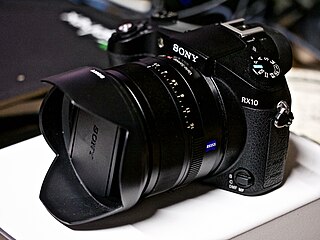
The Sony Cyber-shot DSC-RX10 is a digital superzoom bridge camera made by Sony. It was announced on October 16, 2013.
The Sony Cyber-shot DSC-QX30 is an ultrazoom, mobile device-mountable, lens-style compact camera manufactured by Sony. Announced on September 3, 2014, the QX30 is one of Sony's "Smart Lens" cameras, alongside the QX1, QX10 and QX100, that are designed to be specifically used with a smartphone. It has a 1/2.3 inch backside-illuminated Exmor R™ CMOS sensor with 20.4 effective megapixels, sitting behind an ƒ/3.5 (wide) to ƒ/6.3 (telephoto) Sony G Lens. Its highlight feature is its 30x lossless optical zoom.

The Canon PowerShot G7 X is a compact digital camera announced by Canon Inc on September 15, 2014. It did not replace any model in the Canon line-up. Instead, it was a new camera intended to compete with the Sony Cyber-shot DSC-RX100-series cameras. With the introduction of G7 X, there were three parallel models in the Canon PowerShot G-series: G16, G1 X Mark II, and G7 X.
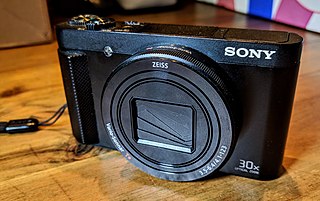
The Sony Cyber-shot DSC-HX90V is a superzoom compact camera, which can zoom up to 30x; equivalent to 24-720mm. At the time of its release, it is the world's smallest superzoom digital camera. It features optical image stabilization, an AF Illuminator, an 18.2MP BSI Active pixel sensor and has customizable settings. The camera has a pop-up OLED electronic viewfinder that has 638,400 dots and is far brighter than any other conventional electronic viewfinders. The camera’s screen is a 3" TFT LCD that tilts upward 180 degrees. Also borrowed from the RX100 is a customizable ring around the front of the lens. The HX90V can record video at 1080/60p using the XAVC S codec, which allows for bit rates up to 50MBps. The camera has a built-in GPS; used for geotagging. The camera also has built-in Wi-Fi with NFC and Bluetooth, which means you can connect your camera to your phone or tablet by using PlayMemories Camera Apps.
The Sony Cyber-shot DSC-RX100 IV is a digital premium compact camera announced by Sony on June 10, 2015 as the fourth entry in the Sony Cyber-shot DSC-RX100 series. It is one of a pair of cameras launched together by Sony that use their new stacked CMOS sensor. The other camera is the Sony Cyber-shot DSC-RX10 II, a model providing a larger lens and greater zoom, but less compact body.
The Sony Cyber-shot DSC-RX10 II is a DSLR-styled digital bridge camera announced by Sony on June 10, 2015. Its main improvement over its predecessor, the 2013 Sony Cyber-shot DSC-RX10, is its 2160p 4K video recording ability, as well as added high-framerate with 1080p doubled to 120fps, and high speed video at 240fps, 480fps, and 960fps.

The Sony RX is the name of a range of fixed lens compact point-and-shoot digital cameras created by Sony in 2012. All cameras are equipped with Carl Zeiss lenses.
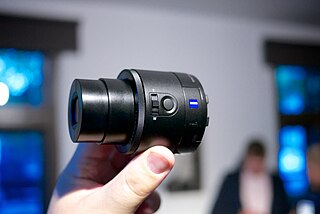
The Sony Cyber-shot DSC-QX100 is a mobile device-mountable lens-style compact camera manufactured by Sony. Announced on September 3, 2014, the QX100 is one of Sony's "Smart Lens" cameras, alongside the QX1, QX10 and QX30, that are specifically designed to be used with a smartphone. Its highlight features are its 1-inch backside-illuminated Exmor R CMOS sensor taken straight from the Sony RX100 II premium compact camera, with 20.2 megapixels, ƒ/1.8 to ƒ/4.9 Carl ZEISS® Vario-Sonnar T* lens and a 3.6x (28–100 mm) optical zoom.

The Sony Cyber-shot DSC-WX500 is a digital selfie compact camera, which can zoom up to 30x; equivalent to 24–720 mm. Its TFT LCD screen can tilt up to 180º, it has a built-in flash and a built-in AF illuminator. It also has an Exmor R CMOS sensor and a BIONZ X image processing engine. Its customizable ring is borrowed from the Sony Cyber-shot DSC-RX100, around the front of the lens. The camera also has built-in Wi-Fi with NFC with downloadable apps, but no GPS. The WX500 features Optical Image Stabilisation.
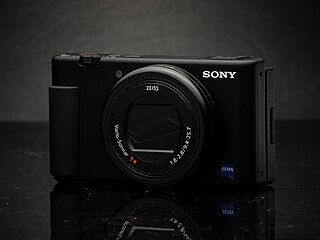
The Sony ZV-1 is a 20MP Sony compact digital camera with a 1-inch image sensor. It is similar to the Sony RX100 V with extra features, such as features for vlogging and quick video production. The camera can record video in XAVC S and AVCHD formats. The camera was released in May 2020 as part of Sony's ZV line-up. Its launch price was $799, with a pre-order price of $749. This was the first camera in the Sony ZV line-up. The camera comes in two different colours, black or white. It also comes in a vlogging kit as an optional extra. The camera is likely a successor to the RX100 Mark VII, as Sony hadn't released a RX100 since 2019.
















